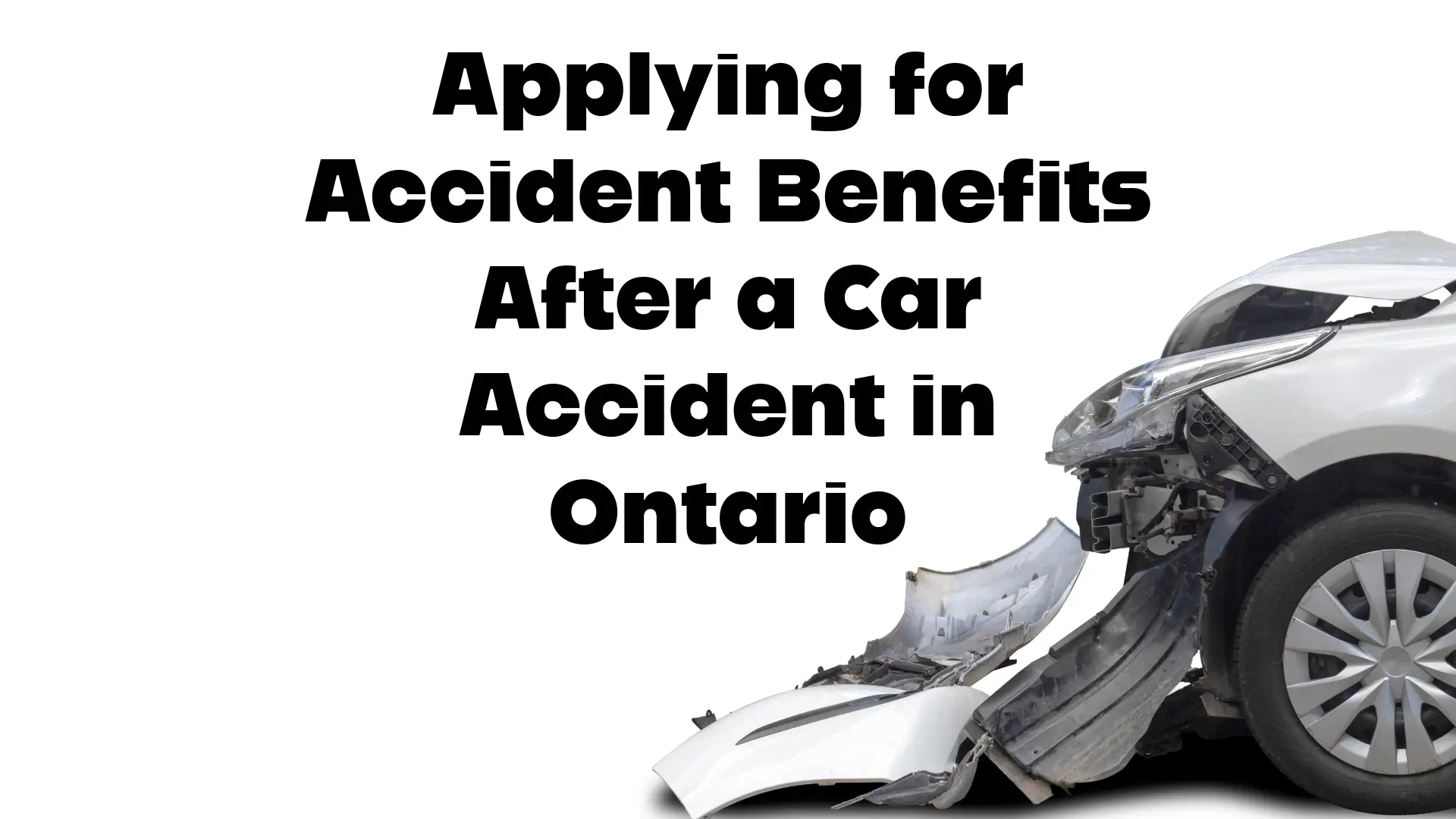
Supporting the 2025 Lakeridge Health Foundation’s Golf Classic
It was my honour and privilege to help support Lakeridge Health Foundation as a Bogey Partner to their 2025 Golf Classic at Coppingwood Golf Club on July 14, 2025.

Car accidents can leave a trail of confusion and stress in their wake, not just from the physical injuries but also from the paperwork and processes that follow. If you’ve recently been in a car accident in Ontario, understanding how to apply for Accident Benefits can be your first step toward recovery. This comprehensive guide will walk you through everything you need to know about Accident Benefits, helping you secure the support you need during this challenging time.
Accident Benefits are a crucial component of Ontario’s no-fault insurance system, designed to provide immediate financial relief and support to accident victims, regardless of who was at fault. Whether you are a driver, passenger, pedestrian, or cyclist injured in a motor vehicle accident, these benefits can cover medical expenses, lost income, and more.
In this post, we’ll break down the intricate details of the Statutory Accident Benefits Schedule (SABS), guide you through the application process, outline important time limits, and provide tips to avoid common mistakes. We’ll also discuss how to handle insurers, the special considerations for catastrophic injuries, and when it’s wise to consult a personal injury lawyer. By the end, you’ll be equipped with all the knowledge you need to successfully apply for Accident Benefits and start your road to recovery.
Accident Benefits are a lifeline for those injured in car accidents, providing financial support for medical treatments, rehabilitation, income replacement, and more. These benefits are part of Ontario’s no-fault insurance system, meaning you can claim them regardless of who caused the accident.
Eligibility for Accident Benefits extends beyond drivers to include passengers, pedestrians, and cyclists involved in a motor vehicle accident. This inclusivity ensures that anyone affected by an accident has access to the necessary support for their recovery.
The benefits provided can cover a wide range of needs, from medical and rehabilitation expenses to attendant care, income replacement, and even death benefits for families who have lost a loved one in an accident. Understanding these benefits is the first step to navigating the complex landscape of post-accident recovery in Ontario.
The Statutory Accident Benefits Schedule (SABS) is the framework that outlines the specific benefits available to accident victims in Ontario. SABS is divided into various sections, each detailing different types of coverage and the conditions under which they apply.
These benefits cover expenses related to medical treatments and rehabilitation services required due to the accident. They can include physiotherapy, chiropractic treatment, and psychological counseling, ensuring you receive comprehensive care for your recovery.
If your injuries prevent you from working, income replacement benefits can provide financial support. These benefits typically cover 70% of your gross income, up to a maximum weekly amount, helping you manage your finances during your recovery period.
For those not employed at the time of the accident, non-earner benefits offer financial support if your injuries prevent you from returning to your normal activities. These benefits can be crucial for students, homemakers, or retirees affected by the accident.
For victims with severe, life-altering injuries, catastrophic injury benefits provide additional support. These benefits cover extensive medical and rehabilitation costs, as well as higher limits for attendant care and other necessary services.
Understanding the SABS and the specific benefits it offers can help you identify the types of support you may be eligible for, ensuring you receive the comprehensive care and financial assistance needed for your recovery.
Applying for Accident Benefits involves several steps, each crucial to securing the support you need. Here’s a step-by-step guide to help you through the process:
After the accident, notify your insurance company as soon as possible. They will provide you with the necessary forms and information to begin your claim for Accident Benefits. Timely notification is essential to ensure your claim is processed without delays.
The application for Accident Benefits typically includes several forms, such as the OCF-1 (Application for Accident Benefits), OCF-2 (Employer Confirmation Form), and OCF-3 (Disability Certificate). Carefully complete these forms, providing detailed and accurate information about the accident and your injuries.
Along with your application forms, submit any supporting documentation required by your insurer. This may include medical reports, receipts for medical expenses, and proof of income. Ensure all documents are complete and submitted promptly to avoid any delays in processing your claim.
Maintain detailed records of all communications with your insurer, medical providers, and any expenses related to your injuries. These records can be invaluable in supporting your claim and resolving any disputes that may arise.
By following these steps meticulously, you can streamline the application process and ensure you receive the Accident Benefits you’re entitled to.
Meeting deadlines is crucial when applying for Accident Benefits. Ontario’s insurance regulations impose strict time limits, and missing them can result in the denial of your claim.
You must notify your insurance company of the accident within seven days. If you’re unable to do so due to your injuries, have someone else notify them on your behalf. Prompt notification ensures your claim is acknowledged and processed without delays.
Submit your completed application forms within 30 days of receiving them from your insurer. Missing this deadline can jeopardize your claim, so prioritize completing and submitting the forms promptly.
Continue to submit any additional documentation requested by your insurer within specified timeframes. Failing to provide timely documentation can result in delays or denial of benefits.
Adhering to these time limits is essential to securing your Accident Benefits. Keep track of all deadlines and ensure you meet them to avoid any complications with your claim.
Applying for Accident Benefits can be complex, and making mistakes can jeopardize your claim. Here are some common errors to avoid:
Providing incomplete or inaccurate information on your application forms can lead to delays or denial of your claim. Double-check all details before submission to ensure accuracy.
Failing to meet the specified deadlines for notification, form submission, and documentation can result in the denial of your claim. Stay organized and prioritize meeting all deadlines to avoid complications.
Underestimating the severity of your injuries can affect the benefits you receive. Be honest and thorough when describing your injuries and their impact on your daily life and work.
By avoiding these common mistakes, you can increase the likelihood of a successful Accident Benefits claim, ensuring you receive the support you need for your recovery.
Communicating with insurance companies can be challenging, but understanding your rights and knowing how to handle disputes can make the process smoother.
Maintain clear and detailed communication with your insurer. Keep records of all interactions, including phone calls, emails, and letters. Clear communication can help resolve issues promptly and prevent misunderstandings.
Familiarize yourself with your rights under Ontario’s insurance regulations. Knowing your rights can empower you to advocate for yourself effectively and ensure you receive fair treatment from your insurer.
If your claim is denied, don’t panic. Review the reasons for denial and gather any additional documentation required to support your claim. You have the right to appeal the decision, and seeking legal counsel can help ensure a fair resolution.
Navigating interactions with insurers can be daunting, but being well-informed and proactive can help you secure the benefits you’re entitled to.
For victims with catastrophic injuries, the road to recovery can be particularly challenging. Special considerations and benefits are available to provide the necessary support.
Catastrophic injury benefits cover extensive medical treatments and rehabilitation services, ensuring you have access to the care needed for your recovery. These benefits can include home modifications, mobility aids, and specialized therapies.
Victims with catastrophic injuries are eligible for higher financial limits for benefits such as attendant care and housekeeping services. These higher limits ensure you receive the comprehensive support needed for your long-term recovery.
Catastrophic injuries often require long-term planning and support. Work with healthcare providers and legal counsel to develop a comprehensive care plan that addresses your immediate and future needs.
Understanding the special considerations for catastrophic injuries can help you access the full range of benefits and support available, ensuring your recovery is well-supported.
Navigating the Accident Benefits process can be complex, and having legal counsel can provide invaluable support.
Personal injury lawyers specialize in Accident Benefits claims and can provide expert guidance throughout the process. They can help you understand your rights, complete application forms, and gather the necessary documentation.
If disputes arise with your insurer, a personal injury lawyer can advocate on your behalf, ensuring your claim is fairly reviewed and processed. They can also represent you in appeals and legal proceedings, if necessary.
Legal counsel can help ensure you receive fair compensation for your injuries and losses. They can review your claim, identify any additional benefits you may be entitled to, and negotiate with your insurer to secure the best possible outcome.
Seeking legal counsel can provide peace of mind and ensure your Accident Benefits claim is handled professionally and effectively.
Understanding and applying for Accident Benefits after a car accident in Ontario is crucial for your recovery. By familiarizing yourself with the SABS, following the application process, meeting deadlines, and avoiding common mistakes, you can secure the support you need.
Dealing with insurers can be challenging, but clear communication and knowing your rights can help. For victims with catastrophic injuries, special considerations and higher benefits are available to provide comprehensive support.
In many cases, seeking legal counsel can ensure a smooth and successful claims process, helping you receive fair compensation and access to the necessary resources for your recovery.
If you’ve been in a car accident in Toronto, don’t hesitate to seek the support and guidance needed to apply for Accident Benefits. Reach out to our personal injury lawyers today and take the first step toward securing the financial and medical support essential for your recovery.
To learn more about how to apply for Accident Benefits and receive professional guidance, request a free consultation with one of our experienced personal injury lawyers.

It was my honour and privilege to help support Lakeridge Health Foundation as a Bogey Partner to their 2025 Golf Classic at Coppingwood Golf Club on July 14, 2025.

Your Burning Question: Why Are Insurance Premiums So High? Homeowners across Ontario are feeling the financial strain as home insurance premiums continue their steady climb.

It is a fundamental strategic decision in litigation: to offer nothing, or to offer next to nothing, in hopes of forcing a plaintiff to abandon

Davidson Cahill Morrison LLP is pleased to announce that several of its distinguished lawyers have been recognized in the 2026 edition of The Best Lawyers